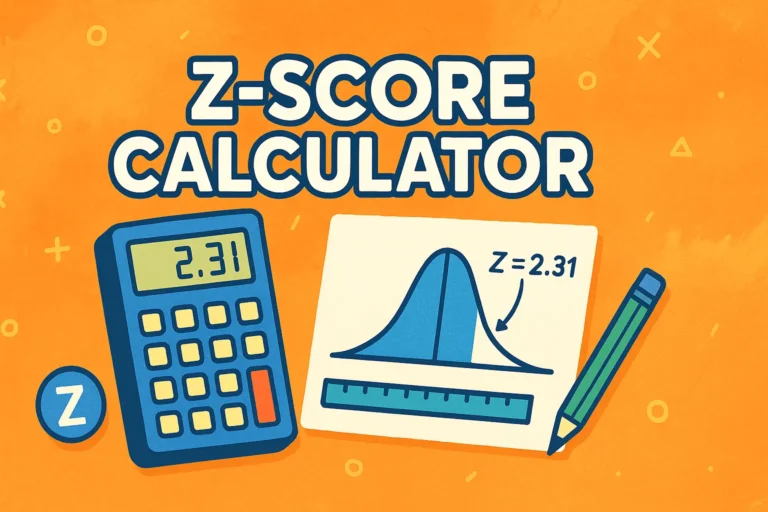Z-Score Calculator: Calculate Standard Score with Formula
A z-score calculator computes standardized scores (standard scores or z-values) that indicate how many standard deviations a data point is from the mean, transforming raw scores into a standardized scale with mean of 0 and standard deviation of 1 using the formula z = (x - μ) / σ, enabling comparison across different scales, distributions, and populations. This essential statistical tool calculates z-scores from raw values, converts z-scores to percentiles and probabilities, determines areas under normal curve, identifies outliers, and provides complete step-by-step calculations with interpretations essential for students, researchers, data analysts, psychologists, educators, and professionals in statistics, standardized testing, quality control, research methodology, and any field requiring standardization of scores for comparison, analysis, hypothesis testing, or understanding relative position within distributions in academics, psychology, business analytics, and scientific research.
📊 Z-Score Calculator
Calculate z-scores and standardized values
Calculate Z-Score from Raw Score
Find z-score using: z = (x - μ) / σ
Convert Z-Score to Raw Score
Find raw score using: x = μ + (z × σ)
Convert Z-Score to Percentile
Find what percentage of data falls below z-score
Understanding Z-Scores
A z-score (also called standard score) measures how many standard deviations a data point is from the mean. Positive z-scores indicate values above the mean, negative z-scores indicate values below the mean, and z = 0 means the value equals the mean. Z-scores allow comparison of scores from different distributions by standardizing them to a common scale.
Z-Score Formula
Basic Z-Score Formula
Z-Score Formula:
\[ z = \frac{x - \mu}{\sigma} \]
Where:
\( z \) = z-score (standard score)
\( x \) = raw score (data point)
\( \mu \) = population mean
\( \sigma \) = population standard deviation
Sample Z-Score Formula
For Sample Data:
\[ z = \frac{x - \bar{x}}{s} \]
Where:
\( \bar{x} \) = sample mean
\( s \) = sample standard deviation
Reverse Formula (Z to Raw Score)
Converting Z-Score to Raw Score:
\[ x = \mu + (z \times \sigma) \]
Rearrangement of the basic formula
Step-by-Step Calculation
How to Calculate Z-Score: Step by Step
Example: A student scores 85 on a test where mean = 75 and SD = 10. Find the z-score.
Step 1: Identify the values
Raw score (x) = 85
Mean (μ) = 75
Standard deviation (σ) = 10
Step 2: Subtract mean from raw score
\[ x - \mu = 85 - 75 = 10 \]
Step 3: Divide by standard deviation
\[ z = \frac{10}{10} = 1.0 \]
Step 4: Interpret the result
Z-score = 1.0
The student's score is 1 standard deviation above the mean.
This is better than approximately 84.13% of students (84th percentile).
Z-Score Interpretation Table
| Z-Score | Interpretation | Percentile (Approx) |
|---|---|---|
| -3.0 | 3 SD below mean (very low) | 0.13% |
| -2.0 | 2 SD below mean (low) | 2.28% |
| -1.0 | 1 SD below mean (below average) | 15.87% |
| 0.0 | At the mean (average) | 50.00% |
| +1.0 | 1 SD above mean (above average) | 84.13% |
| +2.0 | 2 SD above mean (high) | 97.72% |
| +3.0 | 3 SD above mean (very high) | 99.87% |
Common Z-Score Values and Percentiles
| Z-Score | Area Below (Percentile) | Area Above | Two-Tailed |
|---|---|---|---|
| ±1.645 | 90% (one-tail) | 10% | 90% CI |
| ±1.960 | 95% (one-tail) | 5% | 95% CI |
| ±2.576 | 99% (one-tail) | 1% | 99% CI |
Detailed Examples
Example 1: Test Score Comparison
Problem: Sarah scored 90 on Test A (mean=80, SD=5) and 85 on Test B (mean=75, SD=8). Which test did she perform better on relative to her peers?
Test A:
\[ z_A = \frac{90 - 80}{5} = \frac{10}{5} = 2.0 \]
Test B:
\[ z_B = \frac{85 - 75}{8} = \frac{10}{8} = 1.25 \]
Conclusion: Sarah performed better on Test A (z=2.0) compared to Test B (z=1.25) relative to her peers, even though her raw score was higher on Test A.
Example 2: Identifying Outliers
Problem: A dataset has mean=100 and SD=15. Is a value of 160 an outlier?
Calculate z-score:
\[ z = \frac{160 - 100}{15} = \frac{60}{15} = 4.0 \]
Interpretation: z = 4.0 is 4 standard deviations above the mean. Values with |z| > 3 are typically considered outliers. Therefore, 160 is an outlier.
Real-World Applications
Education & Testing
- Standardized tests: SAT, ACT, GRE scores normalized across years
- Grade comparison: Compare performance across different tests
- Percentile ranks: Determine student ranking within cohort
- Pass/fail cutoffs: Set performance thresholds
Psychology & Medicine
- IQ scores: Standardized intelligence testing (mean=100, SD=15)
- Growth charts: Child height/weight percentiles
- Clinical assessments: Abnormal test results identification
- Psychological scales: Depression, anxiety screening
Business & Finance
- Stock performance: Compare returns across different stocks
- Quality control: Identify defective products (6 Sigma)
- Credit scores: Standardized creditworthiness assessment
- Sales analysis: Identify exceptional or poor performance
Empirical Rule (68-95-99.7 Rule)
For normal distributions:
- 68% of data falls within z = ±1 (μ ± 1σ)
- 95% of data falls within z = ±2 (μ ± 2σ)
- 99.7% of data falls within z = ±3 (μ ± 3σ)
Example: If mean IQ = 100, SD = 15:
68% of people have IQ between 85-115 (z = ±1)
95% of people have IQ between 70-130 (z = ±2)
99.7% of people have IQ between 55-145 (z = ±3)
Tips for Using Z-Scores
Best Practices:
- Check normality: Z-scores most meaningful for normal distributions
- Use population parameters: Use σ and μ when available; use s and x̄ for samples
- Interpret in context: Consider what z-score means for specific application
- Compare apples to apples: Only compare z-scores from similar distributions
- Identify outliers: |z| > 3 typically indicates outliers
- Report with percentiles: Percentiles often more intuitive than z-scores
- Understand limitations: Z-scores don't indicate causation or importance
Common Mistakes to Avoid
⚠️ Z-Score Calculation Errors
- Wrong sign: Remember negative z-scores are below mean
- Using wrong SD: Make sure to use correct SD (population vs sample)
- Dividing by mean: Divide by SD, not mean
- Comparing across different populations: Z-scores only comparable within same reference group
- Assuming normality: Z-scores less meaningful for skewed distributions
- Ignoring units: Z-scores are unitless (dimensionless)
- Treating z as percentage: Z-score ≠ percentile (must convert)
Frequently Asked Questions
What is a z-score and how do you calculate it?
Z-score measures how many standard deviations a value is from the mean. Formula: z = (x - μ) / σ. Calculated by subtracting mean from raw score, then dividing by standard deviation. Example: score of 85 with mean 75 and SD 10 gives z = (85-75)/10 = 1.0. Positive z-scores are above mean, negative below. Z=0 means value equals mean. Standardizes different scales for comparison. Essential for statistics, hypothesis testing, percentile calculations, and identifying outliers.
How do you interpret a z-score?
Z-score tells you how unusual a value is. Z=1 means 1 standard deviation above mean (84th percentile). Z=-1 means 1 SD below mean (16th percentile). Z=0 is exactly average (50th percentile). |z| > 2 is unusual (beyond 95% of data). |z| > 3 is very unusual (beyond 99.7%), often considered outlier. Higher absolute value = more extreme. Context matters: z=2 might be normal in one application, extraordinary in another. Always interpret relative to reference population and distribution.
What does a negative z-score mean?
Negative z-score means value is below the mean. Z=-1 means 1 standard deviation below average. Z=-2 means 2 SD below average. Does not mean "bad"—just indicates below-average position in distribution. Example: if lower scores are better (golf, defects), negative z-score is good. Negative z-scores common and normal—about 50% of values in symmetric distribution are negative. Absolute value shows distance from mean regardless of direction. Sign shows direction: negative=below, positive=above.
How do you convert z-score to percentile?
Use standard normal table (z-table) or calculator. Table shows area under curve to left of z-score, which equals percentile/100. Example: z=1.0 corresponds to 0.8413, meaning 84.13th percentile. Common values: z=0 → 50th percentile, z=1 → 84th, z=2 → 98th, z=-1 → 16th. Online calculators fastest. Excel: =NORM.S.DIST(z,TRUE). Percentile tells you what percentage scored below that z-score. More intuitive than z-scores for non-statisticians. Convert both ways depending on need.
When should you use z-scores?
Use z-scores when: (1) Comparing scores from different scales (SAT vs ACT), (2) Identifying outliers in dataset, (3) Calculating percentiles for normal distributions, (4) Standardizing data for machine learning, (5) Conducting hypothesis tests (z-tests), (6) Creating standardized reports, (7) Quality control (Six Sigma), (8) Comparing individual to population norm. Most effective with normally distributed data. Don't use for small samples (<30) or highly skewed distributions—consider alternatives like percentiles or other transformations. Always verify normality assumption first.
What's the difference between z-score and t-score?
Z-score uses population standard deviation (σ), assumes normal distribution, used with large samples (n≥30) or known population parameters. T-score uses sample standard deviation (s), accounts for additional uncertainty in small samples (n<30), follows t-distribution (fatter tails). Formula similar: t = (x-x̄)/s. As sample size increases, t-distribution approaches normal, and t-scores approach z-scores. Use z when population SD known; use t when estimating from sample. Both standardize scores but for different scenarios. T more conservative with small samples.
Key Takeaways
Z-scores are powerful standardization tools that transform raw data into a common scale, enabling meaningful comparisons across different measurements, populations, and contexts. Understanding z-scores is fundamental for statistics, research, standardized testing, and data analysis in numerous fields.
Essential principles to remember:
- Z-score formula: z = (x - μ) / σ
- Measures standard deviations from the mean
- Positive z-scores are above mean; negative are below
- Z = 0 means value equals the mean
- Most values fall between z = -3 and z = +3
- 68-95-99.7 rule applies to normal distributions
- Z-scores enable comparison across different scales
- Convert to percentiles for easier interpretation
- |z| > 3 typically indicates outliers
- Most meaningful for normally distributed data
Getting Started: Use the interactive calculator at the top of this page to calculate z-scores from raw scores, convert z-scores back to raw values, or determine percentiles. Enter your values (raw score, mean, and standard deviation), and receive instant results with detailed explanations, interpretations, and percentile rankings. Perfect for students, researchers, educators, and anyone working with standardized scores and statistical analysis.

